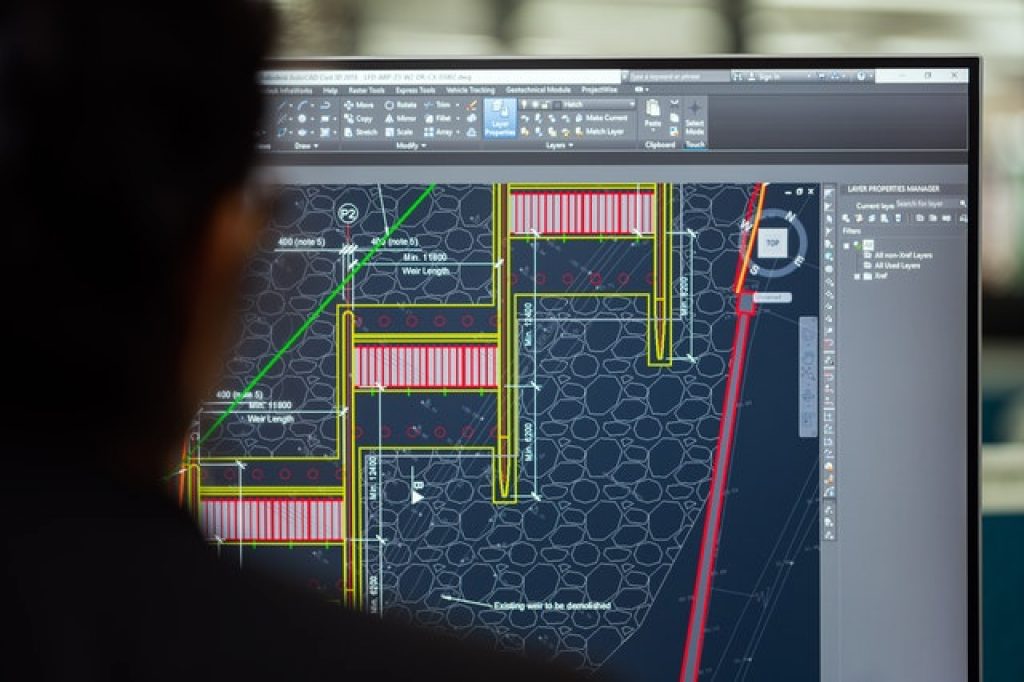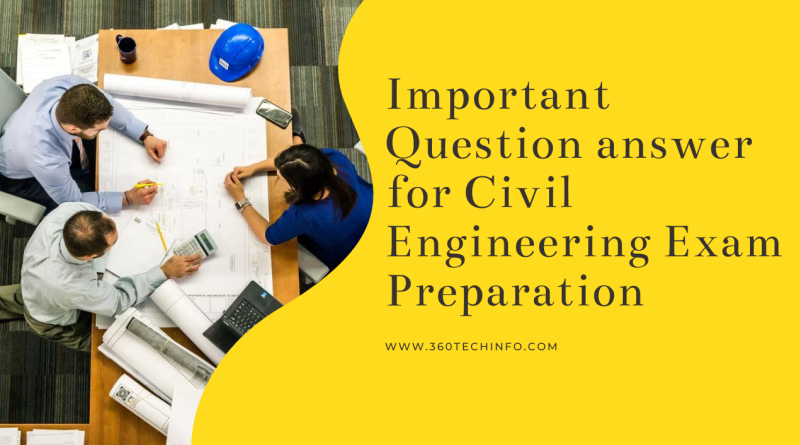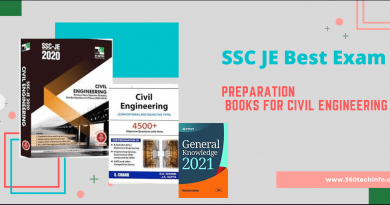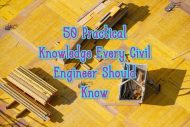Important Question answer for Civil Engineering exam Preparation
In this article, we are going to discuss with you the top most important question answer for the civil engineering exam. MCQ Questions are most impotent for the exam. I am trying to share with you the most important of them with you. Stay connected with us for more topics like this. View the following question and brush up your studies in civil engineering Objective questions and Answer very regularly for preparation of various competitive and entrance exams,

Question answer for Civil Engineering exam Part I
| # | Questions | Options | Answer |
|---|---|---|---|
| 1. | Deduction for a total length of the central line at the corner where two walls meet is | 1. Thickness of the wall 2. Half thickness of the wall 3. Twice of the thickness wall 4. No deduction | 4. No deduction |
| 2. | The main purpose of the soundness test of the cement is to determine the | 1. Strength 2. change in Volume of cement after setting 3.Fitness 4. Time taken to harden | 2. change in Volume of cement after setting |
| 3. | Pug mill is used in which process? | 1. Moulding of clay 2. Preparation of clay 3. Burning of Bricks 4. Drying of bricks | 2. Preparation of clay |
| 4. | Which of the following used as vehicle in the enamel paints? | 1. Varnish 2. Mustard oil 3. Water 4. Linseed Oil | 1. Varnish |
| 5. | Accuracy in the measurement of the volume in cubic meter should be near to | 1. 0.001 2. 0.02 3. 0.01 4. 0.1 | 3. 0.01 |
| 6. | Deduction for total length of the central line at the corner where two walls meet it | 1. Thickness of wall 2. Half of thickness of the wall 3. No deduction 4. Twice of the thickness of wall | 3. No deduction |
| 7. | Which of the following is estimated by using a bar bending schedule? | 1. Earthwork 2. Brick work 3. Concrete work 4. Steel work | 4. Steel work |
| 8. | Which of the following is measured in Square meter? | 1. Steel reinforcement bar 2. Shuttering 3. Concrete work 4. Earthwork | 2. Shuttering |
| 9. | Plumb bob lines at two different places in plane surveying are- | 1. Inclined 2. Parallel to each other 3. Perpendicular to each other 4. Cut at the center of the earth | 4. Cut at the center of the earth |
| 10. | The line which is used to collect the details of the object in an area is called | 1. Base line 2. Main line 3. Check line 4. Tie line | 4. Tie line |
| 11. | The least count of a theodolite is- | 1. 1 Degree 2. 2 minutes 3. 2 Seconds 4. 20 Seconds | 4. 20 Seconds |
| 12. | On increasing temperature, the viscosity of gas- | 1. First increase and then rapidly decrease 2. Decreases 3. Increases 4. Not Effected by temperature. | 3. Increases |
| 13. | Which of the following is responsible for the corrosion of concrete cover? | 1. Oxygen 2. Nitrogen 3. Clorine 4. Septic conditions | 4. Septic conditions |
| 14. | Live load with time can vary in | 1. Magnitude 2. Position 3. Neither position nor magnitude 4. Position as well as magnitude | 4. Position as well as magnitude |
| 15. | As water cement ratio increases, which of the following also increases? | 1. Workability 2. compressive strength 3. Tensile strength 4. Blending | 1. Workability |
You can also read: 50 Practical Knowledge Every Civil Engineer Should Know

Question answer for Civil Engineering exam Part II
| # | Questions | Options | Answer |
|---|---|---|---|
| 16. | Compacting of concrete done to | 1. Introduce air bubble 2. Place concrete on sloping surface 3. Remove air bubbles 4. Place concrete on flat surface | 3. Remove air bubbles |
| 17. | M15 concrete is used for- | 1. Foundations 2. Dams 3. Mass concrete work 4. RCC | 1. Foundations |
| 18. | Before plastering the surface has to be | 1. Rough 2. smooth 3. Cemented 4. Watered | 1. Rough |
| 19. | Wood surface required how much coat of plastering? | 1. 1 2. 2 3. 3 4. None of this | 1. 1 |
| 20. | Which of the below is used to construct very thin, hard and strong surface? | 1. RCC 2. Post Tressed Concrete 3. Ferro Cement 4. None of these | 3. Ferro Cement |
| 21. | How many methods of ferro cementing are there? | 1. 3 2. 2 3. 4 4. 6 | 1. 3 |
| 22. | If a material has identical properties in all directions, it is said to be | 1. Elastic 2. Homogeneous 3. Isotropic 4. None of the above | 3. Isotropic |
| 23. | Distempers are generally used to coat……. | 1. Compound wall 2. Wood works 3. External concrete surface 4. Interior surface which are not exposed to environment | 4. Interior surface which are not exposed to environment |
| 24. | Which of the following is commonly used as retarder in cement? | 1. Gypsum 2. Calcium Sulphate 3. Sodium Chloride 4. Potassium Carbide | 1. Gypsum |
| 25. | Calculate the total correction (m) required, if a line measured using 20 m chain in 2380 m. Actual length of the chain is? | 1. 22.6 2. 23.56 3. 23.8 4. 22.8 | 3. 23.8 |
| 26. | Soundness of cement is tested by | 1. Vicat’s Apparatus 2. Le- Chatelier Apparatus 3. Compressive strength testing apparatus 4. None of these. | 2. Le- Chatelier Apparatus |
| 27. | The coefficient of curvature for well grade soil lies between | 1. 1 to 2 2. 1 to 3 3. 1 to 5 4. 5 to 7 | 2. 1 to 3 |
| 28. | The intermediate site distance equals to | 1. Stopping sight distance 2. Overtaking site distance 3. Twice of stopping site distance 4. Thrice of stopping site distance | 3. Twice of stopping site distance |
| 29. | The coefficient of uniformity for well graded sand must be grater then —- | 1. 5 2. 4 3. 6 4. 10 | 3. 6 |
| 30. | Which type of drainage system will collect the rain water? | 1. Primary 2. Secondary 3. Tertiary 4. Primary and tertiary | 1. Primary |
Question answer for Civil Engineering exam Part III
| # | Questions | Options | Answer |
|---|---|---|---|
| 31. | Bulking of sand is maximum if the moisture content is about | 1. 2 % 2. 4 % 3. 10% 4. 6 % | 2. 4 % |
| 32. | The purpose of reinforcement in prestressed concrete is | 1. To provide adequate bond stress 2. To resists tensile stresses 3. To impart initial compressive stress in concrete 4. All of the above | 3. To impart initial compressive stress in concrete |
| 33. | To minimizes the effect of differential settlement, the area of a footing should be designed for… | 1. Dead load only 2. Dead load plus live load 3. Dead load plus friction of live load 4. The dead load plus faction of dead load | 3. Dead load plus friction of live load |
| 34. | Which cement is generally used for road pavement construction? | 1. ordinary Portland cement 2. rapid hardening cement 3. low heat cement 4. Blast furnace slag cement | 2. rapid hardening cement |
| 35. | The bulk density of aggregates, depends upon | 1. Shape, 2. Grading, 3. Compaction, 4. All of the above | 4. All of the above |
| 36. | To determine modulus of rupture, the size of test specimen used. | 1. 150 x 150 x 500 mm 2. 150 x 150x 700 mm 3. 100 x 100 x 700 mm 4. 100 x 100 x 500 mm | 2. 150 x 150x 700 mm |
| 37. | Admixture which cause early setting and hardening of concrete are called… | 1. Accelerator 2. Retarders 3. Workability admixture 4. Air entrained agent | 1. Accelerator |
| 38. | Water cement ratio is generally expressed in volume of water required per | 1. 20 kg 2. 10 kg 3. 40, kg 4. 50 kg | 4. 50 kg |
| 39. | The surface where to successive placement of concrete meets is called | 1. Expensipn joint 2. Contraction Joints 3. Contraction Joint 4. Both 1 and 2 | 2. Contraction Joints |
| 40. | Development of early crack in reinforced concrete is due to | 1. Stresses of steel 2. Strains of steel 3. Ultimate load 4. Bending of steel | 2. Strains of steel |
Question answer for Civil Engineering exam Part IV
| # | Questions | Options | Answer |
|---|---|---|---|
| 41. | Concrete is weak in? | 1. Tension 2. Bending 3. Loading 4. Compression | 1. Tension |
| 42. | Curing is… | 1. Reduces the shrinkage of concrete 2. Prevent the loss of water by evaporation 3. Preserves the properties of concrete 4. All of the above | 4. All of the above |
| 43. | For the construction of R.C.C like slab, beam, columns, wall, etc. the grate of concrete used in | 1. 1:3:6 2. 1: 1.5: 3 3. 1:2:4 4. 1:1:2 | 3. 1:2:4 |
| 44. | As per IS 456, the number of grades of concrete mixes is | 1. 3 2. 5 3. 4 4. 7 | 4. 7 |
| 45. | The maximum percentage of reinforcement in case of the slabs is limited to | 1. 2 2. 4 3. 6 4. 8 | 2. 4 |
| 46. | The final operation in the finishing floor is known as | 1. Screeding 2. Floating 3. Troweling 4. Finishing | 3. Troweling |
| 47. | The ration of the diameter of reinforcement bars and slab thickness is | 1. 1/5 2.1/4 3. 1/6 4. 1/8 | 4. 1/8 |
| 48. | After casting, an ordinary cement concrete on drying | 1. Expends 2. Mix 3. Shrinks 4. None of these | 3. Shrinks |
| 49. | A T-Shape retaining wall mainly consists of | 1. One Cantilever 2. Two Cantilever 3. Three Cantilever 4. Four Cantilever | 3. Three Cantilever |
| 50. | The rock which is not calcareous is called | 1. Lime stone 2. Chalk 3. Laterite 4. None of these | 4. None of these |
Note: Please comment us on above if you think any changes.





Informative Post, thanks for sharing it.